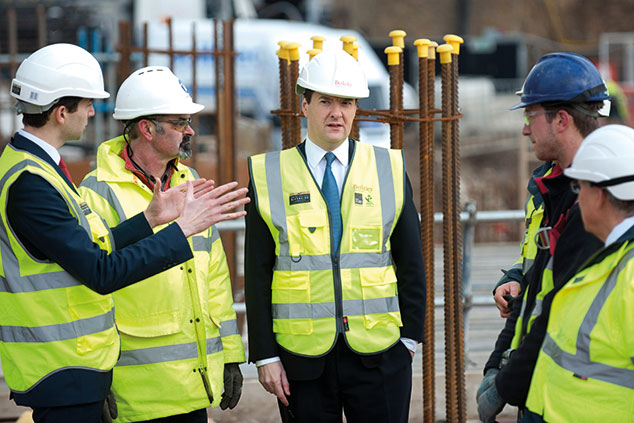
What is Help to Buy?
It’s the government scheme, launched in April 2013, which lets any would-be home buyer in England (not just first time buyers, and not just the less well-off) apply for an equity loan from the state of up to 20% of a property’s value, so long as it’s a new-build home costing up to £600,000 and the buyer can raise a 5% deposit. In London the limit was increased to 40% of the property’s value (from February 2016) to stimulate demand for the scheme in a city where prices are high and take-up is low. The scheme means that new-build buyers only need to raise 75% of the property value via a mortgage (or 55% in London). This government loan is interest-free for the first five years, but it’s not a straight loan, it’s an equity loan. So if the property’s value increases or decreases, the amount you owe the government rises or falls in proportion.
What’s the purpose of the scheme?
The scheme was introduced by the then chancellor George Osborne at a time when property sales had fallen following the financial crash of 2008, and lenders had tightened their loan criteria (under pressure from government regulators). Osborne decided that the way to tackle this was not to use policy to encourage more nuanced and tailored lending practices, but instead to offer buyers state-backed equity loans to help buyers secure high loan-to-value mortgages – and more expensive properties that they might otherwise not have been able to afford. Another aim was to increase the rate of new house building in England by propping up demand.
How’s it been going?
According to the National Audit Office, which earlier this month published a progress report, Help to Buy has definitely helped increase the supply of new-build homes. Since the scheme started, the number of new-build property sales has jumped from 61,357 in 2012-13 to 104,245 in 2017-18. Moreover, the proportion of all property sales accounted for by new-builds has jumped from about 9% to more than 12% (almost one in eight). And since the scheme has been in operation, 38% of all new-build sales have been supported by Help to Buy (equating to 4% of all house purchases).
How many people has it helped?
Up to December 2018, the scheme had made a total of 211,000 loans – 81% of them to first-time buyers – amounting to £11.7bn (an average loan of £55,450). From 2021, the scheme will be restricted to first-time buyers only, and will bring in lower, region-specific caps on the maximum property value (it will stay at £600,000 in London). By then, Homes England (the government agency managing the scheme) projects that it will have lent £22bn, and supported 352,000 purchases. By 2023, when the scheme is due to be withdrawn, about £29bn will have been loaned in total cash terms, supporting 462,000 purchases.
Sounds good?
It’s certainly good news if you are a housebuilder selling new-builds into a market boosted by a wall of taxpayers’ money. MoneyWeek is a long-term sceptic of Help to Buy, for several reasons, but principally because it always looked liked a bizarre form of state subsidy that would push up prices – thus keeping some people out of the housing market even as it helps others into it – and spectacularly boost the profits of a small number of notably undeserving big housebuilders (many of the smaller ones already having gone bust in the 2008-2009 crash). The key beneficiaries are the likes of Persimmon, for example, where the now-departed chief executive Jeff Fairburn accepted a bonus of £75m – a bonus made possible thanks to the fact that half of its sales are Help to Buy, and pre-tax profits passed £1bn earlier this year on all-time-high operating margins of 30.8%.
Who else has gained?
Between them, the nine biggest housebuilders have been making hay, paying out more than £2.3bn in dividends. And worryingly, the National Audit Office progress report offers plenty of other evidence that all these fears were justified all along. For example, fully 63% of buyers who have been helped to buy – almost two-thirds – say they would have bought a home anyway without the state support. Only 37% say they couldn’t have bought, meaning that in practice the scheme can take the credit for only 78,000 extra purchases to date. Previous data have shown that the median household income of applicants is £46,530, and in London it’s £63,558. The NAO report shows that 10% of buyers had incomes of more than £80,000 (£90,000 in London) and 4% earned more than £100,000. In other words, Help to Buy looks horribly like a state subsidy for people who aren’t doing that badly already.
So the buyers are quids in?
Perhaps not. New-build homes come at a price premium of about 16%. And Help to Buy pushed up prices in the new-build sector even further (by 4%-5%, according to Taylor Wimpey’s chief executive Pete Redfern) – a jump that is now unwinding. Unless the market suddenly shoots up, those 211,000 buyers (and counting) will have a hard time selling their properties on for what they paid, leaving them in negative equity (owing more than their house is worth). Even if prices do rise, the need to pay off the (now bigger) equity loan when they sell means they may then struggle to buy again.
Sounds grim?
Indeed. What initially looks like a massive taxpayer transfer to the middle classes “might simply be a deferred penalty instead”, suggests Thomas Hale in the FT. Help to Buy is beginning to look like a “warped, dystopian arrangement where the government enters into some kind of sacrificial loss-sharing arrangement with its main constituency” of relatively well-off home-owners. Making it merely “the 17th strangest item of political news this week”.